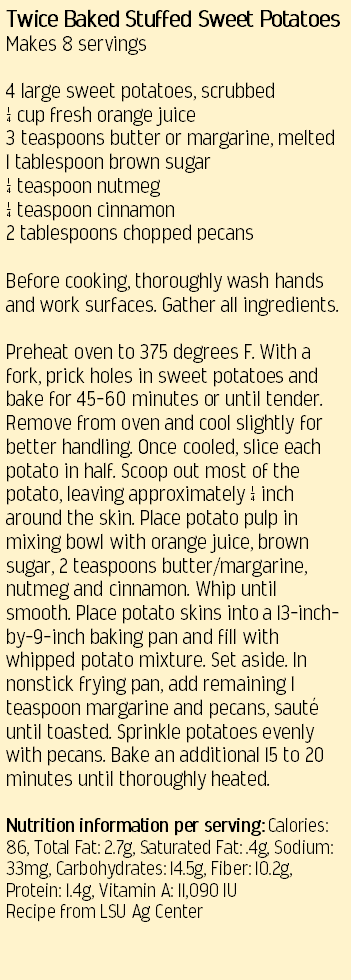|
|
by Denise Sullivan, Field Specialist, Nutrition and Health, University of Missouri Extension Sweet potatoes or yams…which one lands on your holiday menu? Wait…aren’t they the same thing? Though the names are often used interchangeably, the plants are most definitely different. Yams, a member of the lily family, are monocots, and are native to Africa and Asia.
Sweet potatoes, a member of the morning glory family, are dicots and are native to Central and South America. It also bears mentioning that sweet potatoes are not related to Irish potatoes either, which belong to the nightshade family. Yams grow as a vine, which produces an underground tuber with a tough, hairy/scaly skin and flesh that ranges from white to bright yellow to purple or pink. Yams can range from the size of a normal potato to weighing over 100 pounds! Yams are also much starchier and drier than most varieties of sweet potatoes. Sweet potatoes produce a root that has a smooth, thin skin with flesh that ranges in color from white to orange, red, purple, or brown. Sweet potatoes tend to be more ‘normal’ in size, though I have seen friends brag on 10 pound-ers at harvest!z Sweet potato varieties are classified as either ‘firm’ or ‘soft’. Firm sweet potatoes remain firm when cooked and are dry and crumbly, much like a standard baking potato. Soft varieties become more soft, moist, and sweet upon cooking. Freshly harvested sweet potatoes are often referred to as “green” potatoes and are best to go through a curing process to allow the starches to break down into sugar. Curing happens by holding them for about 10 days at 80-85 degrees F with 85-90 percent humidity with good air circulation, or at lower temperatures of 65-75 degrees F for two to three weeks. Both firm and soft varieties are a rich source of Vitamin A, potassium, magnesium and fiber, all of which are beneficial for heart health and blood pressure management. So, why the naming dilemma? According to the Library of Congress and the Louisiana State University Ag Center, the confusion came with the introduction of soft varieties. Southern growers would call the softer potatoes ‘yams’ to differentiate from the firm potatoes, and the term has been used interchangeably ever since. Today the U.S. Department of Agriculture requires labels with the term ‘yam’ to be accompanied by the term ‘sweet potato.’ Unless you specifically search for yams, which are typically found in international markets, you are probably eating sweet potatoes! When it comes to Thanksgiving dinner, sweet potatoes are a common element of the traditional holiday meal. I must admit though, I wasn’t a fan until I was well into adulthood, primarily because how they were presented to me as a child. Though I typically enjoy sweet things, a squishy vegetable doused in brown sugar and marshmallows wasn’t at the top of my list of favorites. Then, while at a conference in North Carolina (producer of about half of the sweet potatoes in the United States) I had my first baked sweet potato. This was the defining moment when I totally changed my mind about this nutrient powerhouse of a vegetable! If you ‘think’ you don’t like sweet potatoes, consider the recipe below as a compromise on your holiday table. You might just change your mind too! Comments are closed.
|
Categories
All
Archives
July 2024
|
Grain Valley NewsGrain Valley News is a free community news source published weekly online. |
Contact Us |




 RSS Feed
RSS Feed
